Location:
PMKI > Project
Controls and Scheduling > Earned Value &
Earned Schedule.

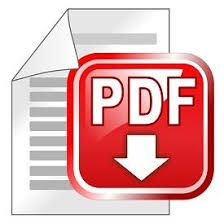
- Earned Value & Earned
Schedule Overview
- Earned Value Processes
- Earned Schedule
- EV & ES Resources and Training
- The VIPER Experience
- Useful External Web-links &
Resources.
Other related sections of the PMKI:
- EVM Training options
- EVM Software Tools
- PMBOK Cost Management
- The history of
Earned Value and Cost Controls
- Work Performance Management
Earned Value Management (EVM) is a performance management system focused on measuring the performance of the people assigned to manage specific work packages, control accounts, and the overall project. It has proven itself to be one of the most effective performance measurement and feedback tools for the management projects, and is often referred to as 'management with the lights on' because it helps objectively and succinctly identify where a project is and where it is going.
EVM is a relatively new technique developed in the 1960s. It was based on PERT COST, which in turn was developed from the PERT TIME scheduling system. EVM also drew on the well-established practice of cost engineering, but with a focus on performance management, see more on the History of Earned Value Management.
The terms Earned Value Management (EVM) and Earned Value Analysis (EVA) are used interchangeably by different authorities. Semantically EVA includes the data gathering, calculations, and analysis used to provide the information needed for EVM, and EVM is the process of manage the ongoing work of a project. However, most standards and references seem to select one name of the other and use it for the full suite of control activities needed to implement an EV system. EVM as used on this page applies equally to EVM and EVA.
This page is focused on the practical implementation of EVM based on ISO 21508 and its Australian implementation as AS 4817:2019. We offer three interlinked components:
The EV methodology incorporates project scope, schedule, and costs and uses the fundamental principle that patterns and trends in the past can be good predictors of the future. Timely and targeted feedback can enable project managers to identify problems early and make adjustments that can keep a project on time and on budget by closing the loop in the classic business formula, 'Plan, Do, Check, Act'.
EVM uses the information derived from the schedule and the cost management function to aid in the overall control of the project (ie, using money as a performance metric), it involves:
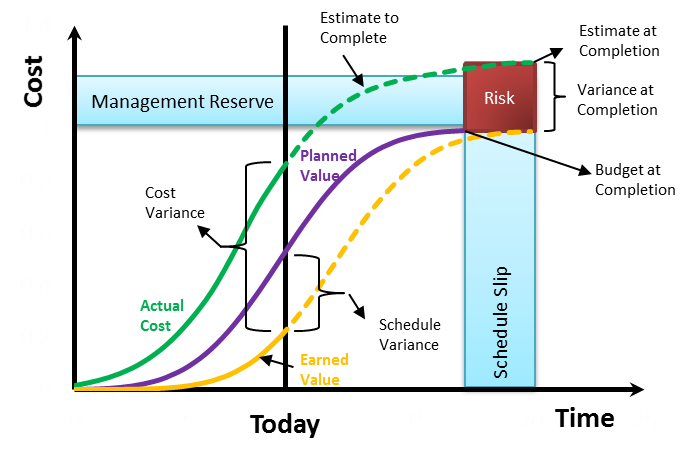 EVM can
play a crucial role in answering management questions that
are critical to the success of every project, such as:
EVM can
play a crucial role in answering management questions that
are critical to the success of every project, such as:
The project manager can use the EVM methodology to help identify:
 Easy
EVM is an introduction to implementing EVM in
an organization based on ISO 21508: Earned Value
Management in Project and Programme Management. Its
purpose is to provide practical guidance to people, and
organizations, involved in either implementing an earned
value management system, or using information created by
an earned value management system. See
more.
Easy
EVM is an introduction to implementing EVM in
an organization based on ISO 21508: Earned Value
Management in Project and Programme Management. Its
purpose is to provide practical guidance to people, and
organizations, involved in either implementing an earned
value management system, or using information created by
an earned value management system. See
more.
A well designed earned value management system (EVMS) adds a number of effective practices in the areas of project planning and control that are related to the goal of measuring, analyzing, forecasting, and reporting on the performance of the project's management team, based on cost and schedule performance data. The information generated is intended for evaluation and action by the project team, managers and other key stakeholders. The foundations are a well defined WBS linked to a realistic cost plan and schedule, but an EVMS is not an extension of the schedule, or the project cost management system. EVM is a performance management system that operates at the management control account level.
Art: The Purpose of Earned Value Management. This article describes the objectives of an effective EVMS and distinguishes EVM from other financial, cost and schedule tools used to control projects.
Art:
Earned Value Management Six things people don’t
get! This article defines the primary
benefits of running an EVMS, and how EVM interacts with,
but is different to, cost control (accounting) systems and
scheduling software. The significance of a robust WBS and
WBS Dictionary is highlighted.
For more on the WBS dictionary click to download an overview of the WBS
Dictionary
(extracted from Sections
2.2.7 and 5.7 of Easy EVM).
Art: Earned Value - An Introduction to Earned Value Performance Management. This article provides a basic overview of the workings of 'Earned Value Management' that is consistent with ISO 21508, and describes how EVM assists in the effective management of projects.
Prs: EVM
– it’s not as hard as you think. Using Earned
Value Management (EVM) to improve project governance and
controls is not as hard as you think! This presentation
looks at establishing, operating, and running an EVMS,
based on Australian Standard AS4817:2019 (the Australian
adoption of ISO 21508), using simple tools. It briefly
covers:
- Understanding EVM, what it is, and what it is not
- Defining the key elements and objectives of EVM, and
- The creation, and use of EVM on a small bridge project.
Prs: Governing and Leading Projects using Earned Value Management (EVM). Good management and good governance requires good information. When implemented effectively EVM is a robust, practical system focused on assessing and supporting the managers of a project. Based on the framework in ISO 21508, this presentation provides an overview of the 11 steps needed to implement EVM effectively.
Prs: Controlling Agile. A review of the decisions, questions and options for effectively integrating project controls and EVM with an 'agile' product delivery methodology.
Art: The CPI Stability Myth. Research has found CPI stability is not a ‘given’ at the 20% or any other stage of a project; and it rarely exists on small commercial projects. EVM is a better predictor of cost outcomes than other options (and using Earned Schedule time outcomes - see below), but all predictions are based on an assumption nothing changes. A negative CPI is a call to action, not a disaster.
Art: Earned Value Confusion = No Value. Using a variety of different acronyms to define the same variable damages the credibility of EV globally.
Work Performance Management is an allied technique designed for use on simpler projects where management has decided not to use EVM. See more.
Art: Practical EVM. An effective Earned Value Management System (EVMS) is a performance management system designed to assist the performance of the project’s management team at predefined control points within the overall structure of the project’s management and control systems. This article outlines the fundamental requirements needed to start developing an EVM culture in an organization using the Easy EVM Workbook.
Art: Sizing Work Packages. The core element at the center of an EVM management system is the work packages; to be useful, they need to be sized appropriately. This article defines the parameters for practical work packages - they are larger then most people think!
WP: Earned Value Formulae. A summary of the basic values and formulae used in Earned Value calculations.
The Easy EVM Workbook is a simple spreadsheet that performs the calculations needed to apply EVM to normal projects (download the instructions for use). It is designed to process the data for a single update. After each update is complete, you save a copy of the spreadsheet ready for the next update and then edit / add the new information at the appropriate time. See more.
 Easy
EVM is a guide to implementing EVM in an
organization using the Easy EVM Workbook,
or a more sophisticated tool. Both Easy EVM,
and the Workbook are based on ISO 21508: Earned
Value Management in Project and Programme Management.
Their purpose is to provide practical guidance to people,
and organizations, involved in either implementing an
earned value management system, or using information
created by an earned value management system. See
more.
Easy
EVM is a guide to implementing EVM in an
organization using the Easy EVM Workbook,
or a more sophisticated tool. Both Easy EVM,
and the Workbook are based on ISO 21508: Earned
Value Management in Project and Programme Management.
Their purpose is to provide practical guidance to people,
and organizations, involved in either implementing an
earned value management system, or using information
created by an earned value management system. See
more.
WP: Understanding the
use of TCPI in EVM. The TCPI is the only EV
metric that can provide a consistent measure of the
likelihood of achieving a target total cost.
Art: Three Steps to Validate a Variance. Variances are to be expected, but before taking action to bring performance back into alignment with the plan, it is a really good idea to make sure the variance you are seeing in the control systems is real and significant.

March 2023 marks the 20th anniversary of the publication by Walt Lipke of his seminal paper Schedule is Different, in the March 2003 edition of The Measurable News, introducing Earned Schedule to the world. To celebrate this milestone Mosaic is supporting a free webinar that will be available to everyone with an interest in Earned Schedule (ES), world-wide. For more information see: https://www.pgcs.org.au/library1/2023-es-special-event/.
It is derived from, and is an extension to, EVM that uses normal EVM data. But, in contrast to the cost-based indicators from EVM, the ES schedule performance indicators are time-based, and provide a status and predictive ability for schedule outcomes, analogous to the facility for cost status and cost predictions when using traditional EVM.
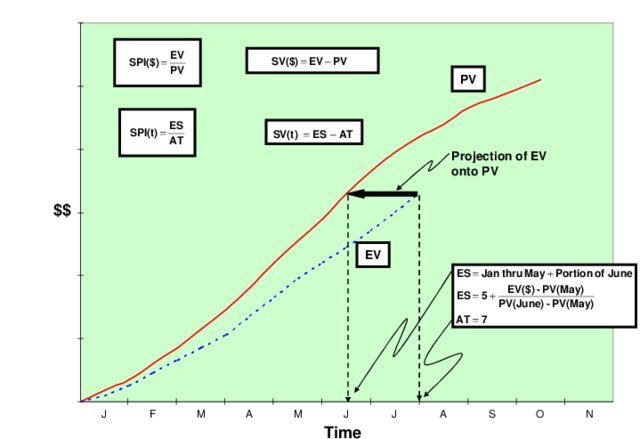 Earned
Schedule (ES) is a breakthrough analytical technique that
resolves two longstanding problems:
Earned
Schedule (ES) is a breakthrough analytical technique that
resolves two longstanding problems:
Art: Earned Schedule. A brief introduction to Earned Schedule.
Art: Predicting project completion. Earned Schedule and the 'P-Factor' - improving forecast completion estimates.
PP: Earned Schedule - the First 20 Years. The concept of Earned Schedule (ES) was introduced to the EVM community In 2003, by the publication by Walt Lipke of Schedule is Different. Earned Schedule resolved the long-standing dilemma of the EVM schedule indicators providing false information for late performing projects, provides the ability to predict project completion dates with more accuracy then CPM, and is the bridge for performing meaningful schedule analysis from the EVM data. It uses the same data as traditional EVM, but shifts the calculations from the cost axis to the time axis. This paper identifies the developments in ES and the quest for an accurate way to predict likely project completion dates. Download the original PMWJ version of this paper.
PP: Why Critical Path Scheduling (CPM) is Wildly Optimistic. CPM tends towards an optimistic representation of the project’s completion date. Used appropriately, this can be a performance motivator. However, prudent management also requires an accurate prediction of the completion date. The ‘critical path’ methodology developed in an environment of certainty. This paper suggests that when dealing with major projects in the modern age, the projected end date calculated by CPM tends to be widely optimistic. However, through the prism of complexity, in particular CRPR, and/or motivational theory this is not necessarily a bad thing. The factors that drive CPM towards an optimistic initial assessment include psychological biases, single point estimates, and limitations of the CPM modelling process (including a factor previously identified as PERT Merge Bias). As work progresses, these initial biases are compounded by the inability of CPM to adjust future predictions based on performance to date. Some of the solutions developed from EV theory such as ‘Earned Schedule’ provide a partial answer but are also limited. From the perspective of CRPR and motivation theory, having an optimistic schedule can be beneficial. The challenge is fitting an optimistic scheduling process within the constraints of an organizational governance structure that requires an accurate prediction of the likely completion date and traditional contracts that demand a ‘contract schedule’ and include significant sanctions if the CPM schedule predictions prove incorrect.
Work Performance Management is an allied technique designed for use on simpler projects where management has decided not to use EVM and ES. See more.
The official site for
Earned Schedule (including the ES calculators) is at:
http://www.earnedschedule.com/
 Easy
EVM is a self-paced course, supported by
Mosaic Project Services Pty Ltd. The purpose of this
‘course-in-a-book’ is to provide practical guidance to
people, and organizations, involved in either implementing
an earned value management system, or using information
created by an earned value management system. It provides
guidance on concepts, responsibilities, integration, and
processes, for the implementation and use of earned value
management based on ISO 21508: Earned Value Management
in Project and Programme Management. Easy EVM,
and ISO21508, are compatible with PMI's The Standard
for Earned Value Management (ANSI/PMI 19-006-2019),
and is a suitable study resource for the EVM component of
the PMI-SP and PMP exams.
Easy
EVM is a self-paced course, supported by
Mosaic Project Services Pty Ltd. The purpose of this
‘course-in-a-book’ is to provide practical guidance to
people, and organizations, involved in either implementing
an earned value management system, or using information
created by an earned value management system. It provides
guidance on concepts, responsibilities, integration, and
processes, for the implementation and use of earned value
management based on ISO 21508: Earned Value Management
in Project and Programme Management. Easy EVM,
and ISO21508, are compatible with PMI's The Standard
for Earned Value Management (ANSI/PMI 19-006-2019),
and is a suitable study resource for the EVM component of
the PMI-SP and PMP exams.
$35.00 AUD (Plus GST, Australian customers only). Size: 240 pages, 100 questions, file size 14 Mb.
Open the Book2Look preview to see the full table of contents, sample pages, and sample questions & answers. Open Book2Look preview
 The
Easy EVM Workbook is a simple spreadsheet
that performs the calculations needed to apply EVM to
normal projects (download the instructions for use).
It is designed to process the data for a single update.
After each update is complete, you save a copy of the
spreadsheet ready for the next update and then edit / add
the new information at the appropriate time. See
more.
The
Easy EVM Workbook is a simple spreadsheet
that performs the calculations needed to apply EVM to
normal projects (download the instructions for use).
It is designed to process the data for a single update.
After each update is complete, you save a copy of the
spreadsheet ready for the next update and then edit / add
the new information at the appropriate time. See
more.
Free Earned Schedule Master Class
Developed by Walt Lipke, hosted by PGCS: Click through to register.
 Standard for Earned Value
Management
Standard for Earned Value
Management
The PMI's The Standard for Earned Value Management
expands on the earned value information in the PMBOK®
Guide and is applicable across many Knowledge Areas
and Process Groups. This practice standard is intended for
anyone who wants to better develop their project
management tool set and know how to potentially improve
project performance through the use of earned value. The
standard expands the available resources on the use of EVM
for medium and smaller projects, whilst still being
relevant for larger projects, provides insight and
detailed explanations of the basic elements and processes
of EVM, and demonstrates how to scale EVM to fit varying
project sizes and situations. The PMI Practice Standard
for Earned Value Management is available free of
charge to PMI members as a non-printing PDF, see: https://www.pmi.org
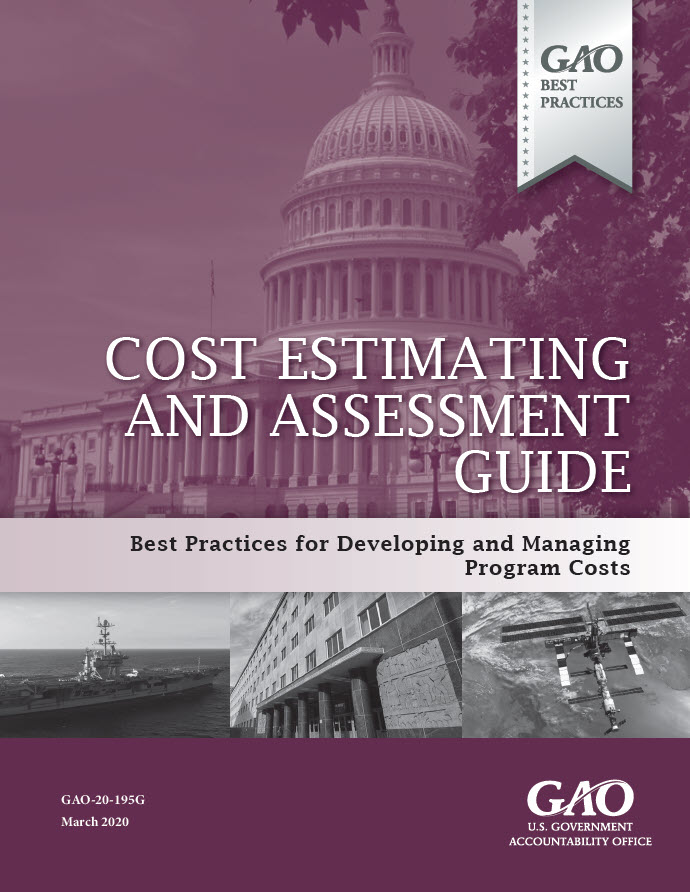 Download
the U.S. Government Accountability Office (GAO) Cost Estimating and Assessment
Guide.
Download
the U.S. Government Accountability Office (GAO) Cost Estimating and Assessment
Guide.
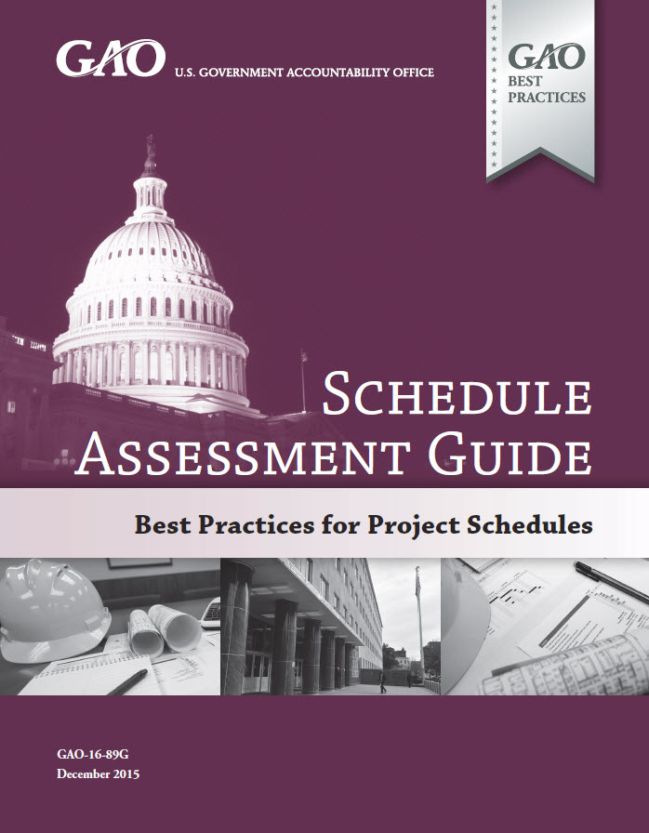 Download
the U.S. Government Accountability Office (GAO) Schedule Assessment Guide.
Download
the U.S. Government Accountability Office (GAO) Schedule Assessment Guide.
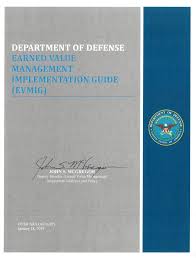 Download
the U.S. DoD Earned
Value Implementation Guide. This guide is
based on the implementation of EVM systems based on the 32
Guidelines contained in the Electronic Industries Alliance
Standard-748 EVMS (EIA-748). This approach to EVM
developed in the 1960s and has largely been superseded by
the performance based approach incorporated in ISO 21508
and the PMI Practice Standard for Earned Value
Management.
Download
the U.S. DoD Earned
Value Implementation Guide. This guide is
based on the implementation of EVM systems based on the 32
Guidelines contained in the Electronic Industries Alliance
Standard-748 EVMS (EIA-748). This approach to EVM
developed in the 1960s and has largely been superseded by
the performance based approach incorporated in ISO 21508
and the PMI Practice Standard for Earned Value
Management.
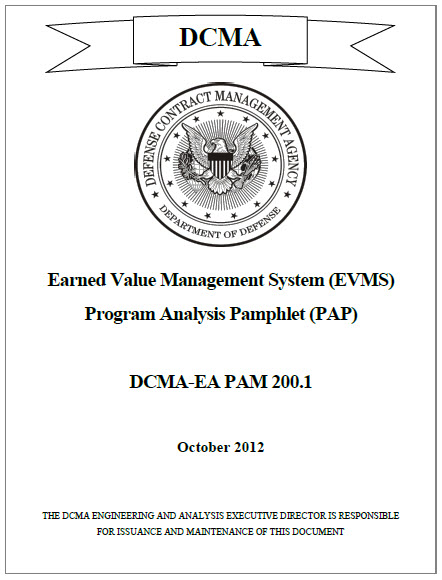 Earned
Value Management System (EVMS) Program Analysis
Pamphlet (PAP), DCMA-EA PAM 200.1, October 2012.
This EVMSPAP was developed as a primary reference for EVMS
Specialists to properly generate EVM metrics, graphs,
tables, and presentations supporting the creation of the
Program Assessment Report (PAR). It outlines EVM key
components spanning the integrated business management
systems and the Integrated Master Schedule (IMS). Section
4 includes the last published version of the DCMA 14
Point Schedule Metrics.
Earned
Value Management System (EVMS) Program Analysis
Pamphlet (PAP), DCMA-EA PAM 200.1, October 2012.
This EVMSPAP was developed as a primary reference for EVMS
Specialists to properly generate EVM metrics, graphs,
tables, and presentations supporting the creation of the
Program Assessment Report (PAR). It outlines EVM key
components spanning the integrated business management
systems and the Integrated Master Schedule (IMS). Section
4 includes the last published version of the DCMA 14
Point Schedule Metrics.
EIA-748-D Standard for Earned Value Management Systems – dated August 2018. A copy of the standard may be purchased from Tech America (www.techamerica.org). EIA-748-D contains a set of 32 guidelines that define the requirements that an Earned Value Management System (EVMS) must meet and is the governing document for its application.
Integrated Program Management Data and Analysis Report (IPMDAR). The IPMDAR contains data for measuring contract execution progress on Department of Defense (DoD) acquisition contracts and may be valuable in developing project controls specifications in a wider environment. The IPMDAR's primary purpose is to reflect current contract performance status and the forecast of future contract performance. Its Data Item Description (DID) contains the format, content requirements, and intended use of information for the data deliverable resulting from the work task described in the solicitation. Download the 2020 IPMDAR.
ISO Standards (with Australian adoptions)
- ISO 21508:2018 Earned value management in project and
programme management
(AS 4817:2019 Earned value management in project
and programme management [modified])
- ISO 21511:2018 – Work breakdown structures for project
and programme management
(AS ISO 21511:2022)
Earned Value Management for Business. This series of workshops are designed to provide executives and practitioners with an understanding of the power of using Earned Value as an effective control and monitoring technique to deliver added value and insight from their overall project control process. The approach adopted is to assume everyone uses some form of software for EV, therefore rote learning of the formulae is pointless. What’s needed is an appreciation of the terms used and the value of the information created by the tools. Workshops are available in half-day, one-day and two-day formats, either as virtual presentations (world-wide), or face-to-face in Australia: view course details.
 VIPER
was a fully-fledged, commercial project control system
that uses Earned Value as its core progress reporting
system. It was designed to optimize repetitive project
cycles (in this case, aircraft maintenance and repair
programs) in a data rich environment.
VIPER
was a fully-fledged, commercial project control system
that uses Earned Value as its core progress reporting
system. It was designed to optimize repetitive project
cycles (in this case, aircraft maintenance and repair
programs) in a data rich environment.
The challenge solved by VIPER remains, business and project communities are facing a number of contradictory pressures:
The combination of these factors creates pressures on business systems (with particular reference to project control systems) to deliver enhanced efficiency and process integrity whilst minimizing risks.
During the heyday of project management software development (in the 1970s and 80s), it was normal for businesses to employ project and senior schedulers in permanent well-paid positions and to maintain staffing continuity within their businesses technical and administrative areas. This structure allowed staff to develop deep domain knowledge and to know, just by looking, when something was incorrect or missing (as well as having the resources to correct the problem). In the leaner, meaner environment of the 21st century, these luxuries are no longer possible. Systems need to be designed with the prudential checks and balances that experienced staff used to be able to provide, incorporated as an intrinsic part of their overall processes (as well as being super efficient).
 The
VIPER system was used to manage and schedule aircraft deep
level maintenance programs for the Australian Defence
Force (ADF) and a number of commercial businesses; it was
retired when the aircraft it was customized to manage
reached the end of their ADF life. VIPER integrates
maintenance data, timesheet data, hangar floor reports and
project scheduling using a number of data integration,
management and automated capture processes, which in
effect created an 'expert' system. VIPER generated cost
savings in excess of 30% to the ADF deep level maintenance
programs. The approach embodied in VIPER allows project
control systems to be designed utilizing the most
effective components (Scheduling, MRP, Timesheet, Data
management, Accounting, etc) and then to integrate the
data capture, information flows and analysis to ensure
prudential processes are mandated whilst optimizing the
overall efficiency of the business unit.
The
VIPER system was used to manage and schedule aircraft deep
level maintenance programs for the Australian Defence
Force (ADF) and a number of commercial businesses; it was
retired when the aircraft it was customized to manage
reached the end of their ADF life. VIPER integrates
maintenance data, timesheet data, hangar floor reports and
project scheduling using a number of data integration,
management and automated capture processes, which in
effect created an 'expert' system. VIPER generated cost
savings in excess of 30% to the ADF deep level maintenance
programs. The approach embodied in VIPER allows project
control systems to be designed utilizing the most
effective components (Scheduling, MRP, Timesheet, Data
management, Accounting, etc) and then to integrate the
data capture, information flows and analysis to ensure
prudential processes are mandated whilst optimizing the
overall efficiency of the business unit.
The evolution of VIPER also provided valuable insights into the way carefully structured information flows can influence business outcomes. These lessons learned are applicable to many process and are discussed in detail at the conclusion of the paper.
PP: The VIPER Experience. This paper analyses the evolution of VIPER as an aircraft maintenance management system over 10 years. It focuses on the use of Earned Value data and other project information as an agent of change and the benefits of automated and integrated management systems.
Managers working in a business environment where key processes have been outsourced are battling to retain control over projects they are responsible for delivering or funding. The key issue they confront is their lack of direct authority to control the destiny of the project. This is caused in part by their lack of visibility of many key commercial processes and in part by the outsourcing model itself. Many levers previously used by project managers to control vendors working on their projects (eg hiring/firing authority, options for future work, payment provisions, knowledge of contracted rates, etc) have been taken away from the project managers working within the ‘client business’ and subsumed into an overall ‘outsource’ agreement.
To succeed in this environment, project managers need to use new techniques to regain effective control of their projects. One of the most effective is to harness the power of Earned Value Analysis to create a high level of visibility (particularly early in the project) and to use the persuasive power created by the regular reporting processes to regain control. Understanding trends and trend analysis is a key part of this process. This process must be implemented with a blend of psychology and technology to obtain the maximum benefit and should focus on helping the vendors become effective and profitable. In an outsourced environment, the clients project managers can only achieve success by making their outsourcing partner successful.
PP: Earned Value Business Management - Using EV to Manage Outsourced Contracts. The practical application of EVM to the management of external contractors and suppliers.
 Earned
Schedule Site - The official site for Earned
Schedule (including the ES calculators): http://www.earnedschedule.com/
Earned
Schedule Site - The official site for Earned
Schedule (including the ES calculators): http://www.earnedschedule.com/
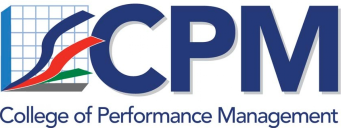 College
of Performance Management - The premiere
organization for earned value management and control: http://www.mycpm.org/
College
of Performance Management - The premiere
organization for earned value management and control: http://www.mycpm.org/
 For papers on EVM and ES presented at the
PGCS Annual Symposium see:
For papers on EVM and ES presented at the
PGCS Annual Symposium see:
https://www.pgcs.org.au/papers/evm/